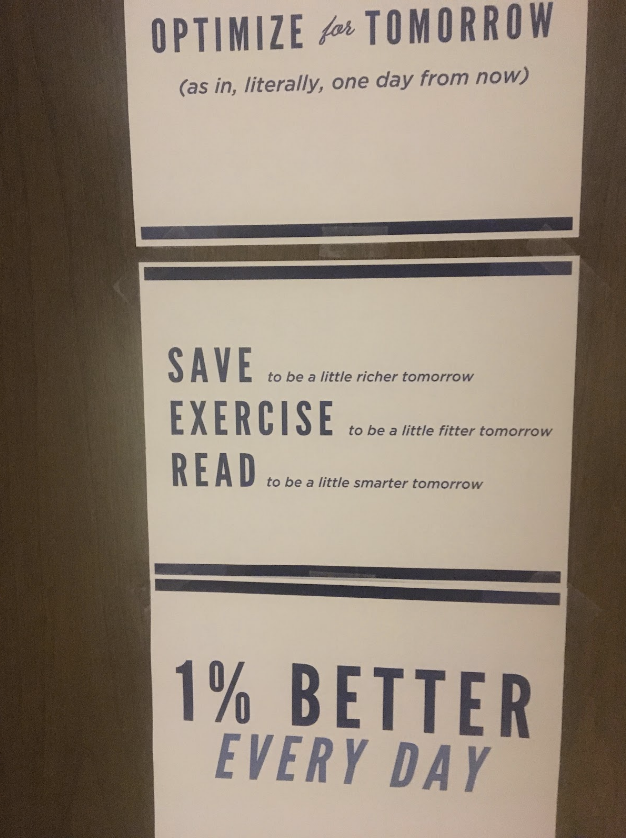We Each Get Only One Today
As COVID-19 social distancing progresses, I find more of the people I speak with — both close friends and strangers (I have been doing pep talks each day for the least few weeks with college students) — sound less active. What once were optimistic and ebullient voices have now often become drained and resigned. So, I have started asking one simple question:
What is your day like?
And herein, I believe, lies some of the problem. There isn’t an answer. There is no real schedule for so many people now. The day, quite literally, just drags by. Which then leads to trepidation over the next day, which drags by just a little more. I have a quote that hangs on my door so I see it every time I leave my place that says 1% Better Every Day. I fear that for many, however, each day is becoming 1% more tiring. Less active. Less meaningful. And for full disclosure, a few have felt that way for me.
So I thought I’d do three things. First, I wanted to say it is incredibly acceptable, even for the most “go-go” of people (I’m one of those) to take a day off and do something self-care focused. Go for a 7 hour hike or watch movies all day. Or schedule nothing and see where the day takes you. I Instagrammed about this is in words that are better than I can express here:
But, you likely aren’t going to take every day off, nor should you. I’ve actually tried taking back-to-back days away from my routine, and I start feeling aimless. At some point, I think that the vast majority of us want to make the most of each day. or at least a part of each day. So, I thought I’d post my daily schedule, which people have been asking me about online for many years — especially those who want to go into higher education or start their own firm. There may be slight variations to this each day, of course, but essentially 7 days a week it looks a heck of a lot like this.
Here’s my schedule.
4:00 – 4:30 AM: Wake up
4:30 – 5:00 AM: Find caffeine; glance over emails
5:00 AM: Move to office and buckle in. Here is a picture of my office at 5 AM
5:00 AM – 7:00 AM: Work emails and writing/podcasting
7:00 AM – 8:00 AM: Trail run or hike
8:30 AM – 10:30 AM: Work calls
10:30 AM – 12:30 PM: Online work/social media
12:30 PM – 1:30 PM: Walk to grocery store (it’s a great walk in a small mountain town); shop and have lunch
2:00 PM – 5:00 PM: All the various work activities I haven’t wanted to do yet (research, incidentally, says you should do these first)
5:00 PM – 7:00 PM: Dinner time/social time at home
7:00 PM – 8:00 PM: Catch up with friends over the phone or more fun home time with my people
8:00 PM – 9:00 PM: TV wind down
9:00 PM – 9:30 PM: Final work emails
9:30 PM: Read in bed
Writing my schedule out feels odd to me, because it isn’t really scheduled — it just happens like this almost every day. But here is the thing. I am active, without even recognizing it, and my day feels very meaningful because of that activity. I would encourage you to write up a mock schedule and then stick to it for the next day our so. See how it feels. Obviously many people right now — those whose jobs haven’t been converted to work-from-home, those who have been laid off or furloughed, etc. — cannot fill their days with things like work calls and emails, but that doesn’t mean you can’t write out a schedule for yourself. In fact, it may be even more important for you to do so if that’s the case. Try something new every day, then see if one of those things lights you on fire; spend your days doing that. Go for runs. Read — two suggestions are Man’s Search for Meaning by Viktor Frankl and Where the Crawdads Sing by Delia Owens. Hell, you can write your own book. Write poetry. Do a deep clean of your home and get rid of anything that doesn’t bring you joy, Marie Kondo-style. In a certain way it almost doesn’t matter what is on your schedule precisely; regardless, if you structure your day and then follow that structure, you may find yourself feeling better than perhaps you were before.
For me, on the rare days I steer off course and do significantly less, my day loses a great deal of meaning. So I think what I am trying to say is this: Socially isolating can seem hard in our minds. And I acutely understand that it can be hard at times. Three years ago I had a jaw issue and couldn’t talk for several months. I had to avoid people because I couldn’t smile at them — it hurt too much. I learned a great deal about myself in that time though, and a lot of that was focusing on the “1% better every day.” It works! I would encourage you to print it up and put it somewhere. Here is mine:


